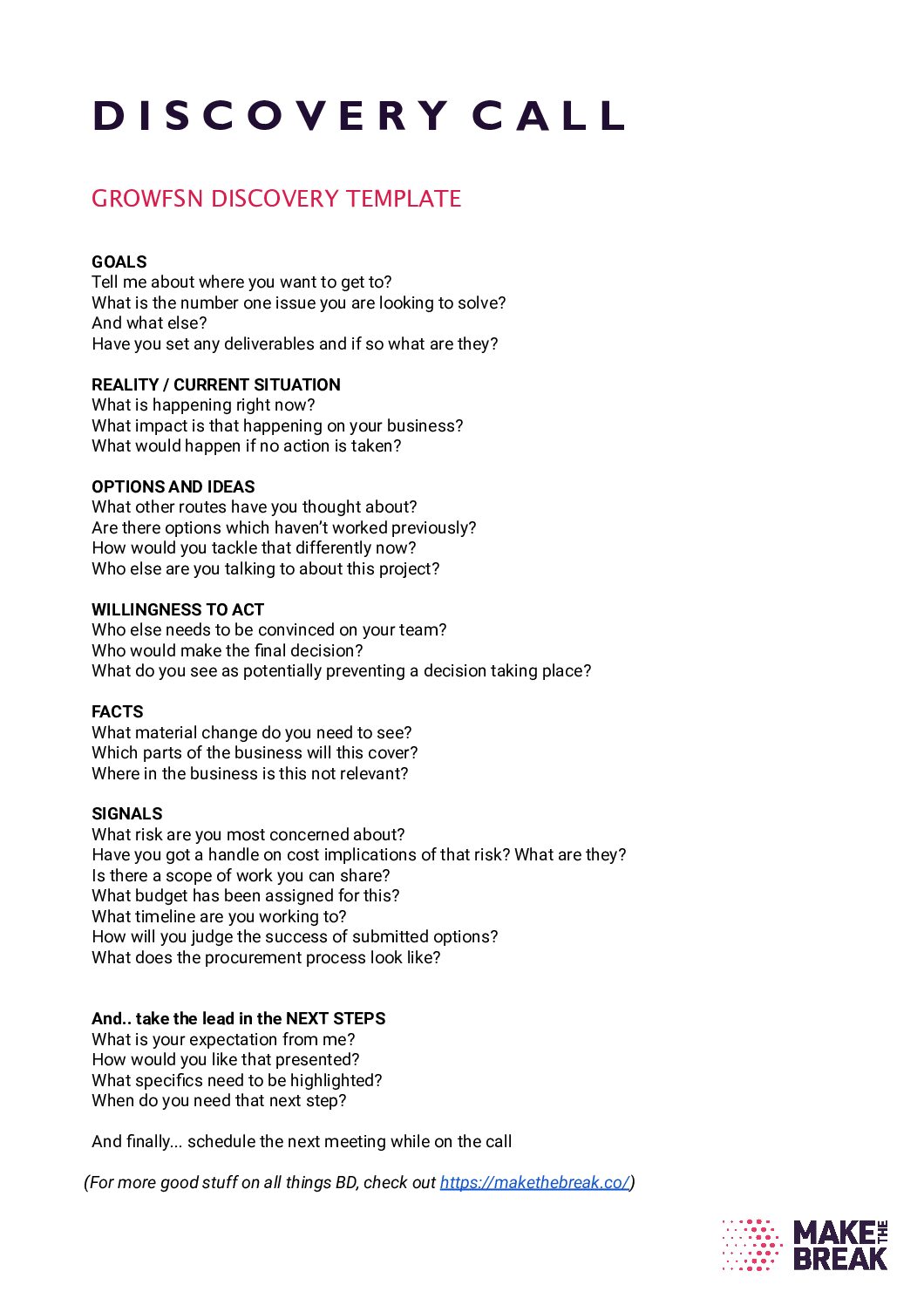
Stu Pringle
Director
Putting structure into discovery
“Failure to plan is planning to fail”
Benjamin Franklin 1790
It may be one of the older quotes you see wanged around on blogs like these, however our mate Benjamin was absolutely spot on when it comes to the B2B sales discovery call.
Before going any further, let’s check in on some definitions. The discovery call is the first call of substance with a prospect. It is, however, probably not the first call. Unless we’re dealing in a simple and low value ‘point and shoot’ product, it is unlikely the sale is going to take place in a single call. If our sales person is trying to shoehorn discovery into the opener, it is very likely doomed to failure.
The discovery call is potentially a super important staging point on the way to a sale. Just getting to this call will have likely taken a significant amount of joined up marketing and sales effort in the run up. (Assuming our prospect shows up of course)

No. Not this discovery.
Why preparation matters
Consequently, the pressure is on. We want to get this right. It is in our best interest that the prospect receives a measured and professional experience. Whether they are about to get interested, whether about to be qualified in or out, we really should be taking sufficient professional pride in our brand (and our personal brand) that we want them to have a positive experience.
So… it’s high stakes then. Going into this kind of situation and winging it might not be a great idea. I write this as someone who has been doing discovery in some shape or form since 2005. I do not do discovery well on the fly. I still need the structure to help guide me through the call and give me the best chance of both uncovering the need and having the right info for a solid follow up.
Discovery models
There are plenty of models out there. The very idea of sales questions are embedded into some of the traditional ways of thinking like SPIN selling and BANT qualification. There are also some lesser known, more advanced models like MEDDIC all of which have some useful elements to cherry pick.
But none of those ‘off the peg’ models have really stuck with me for the long haul. What I’ve found is most of them get you to roughly the same place, some place more focus on budget, others on the client pain, others making sure the wider decision making group are identified. All good stuff… but I’ve found these models a bit contrived. Put simply for me, I never found the conversation felt natural while following their steps.
I’ve gone rogue and creating my own model.
Enter… G.R.O.W.F.S.N
Ok, I agree. The name isn’t great. I suppose if this is to become a thing, I really should give the acronym some polish. But hey, that’s a job for another day. The good news is that this is a model I’ve realised over many years and countless calls.
It starts with the good old consultancy GROW model and it’s tweaked for today’s B2B sales discovery. I use this with my own commercial calls and advocate versions of it when out with clients. Why ‘versions’ you may ask? Not because the client gets some vanilla version, more that the questions they ask as a subset to each section tend to be nuanced to both their market and product.
GROWFSN. Let me explain.

Or this one either.
Goals
We start with establishing where the prospect is right now. This does NOT mean we robotically start the call with saying “what are your key goals”. Ughhh. That kind of opener is not good. It’s too blunt, it puts the prospect on the back foot and probably makes them feel like they are being sold to.
There’s some subtlety here that can really help. Part 2 of this twin blog series is going to go more in depth into the topic of tone of voice, speed of chat, confidence enthused and how the very wording of your question can have a significant impact on the final result.
Instead of “what are your key goals.” Try something like “Tell me about the plan. Where does this business need to get to?”
Reality / Current situation
The next staging point is to find out about the current situation. Again, the move here is not to ask word for word “What. Is. Your. Current. Situation. For. The. Box. In. My. CRM.” Instead, let’s be a bit more natural.
“OK cool, you’ve told me where you need to get to. What do you see happening at the moment…?”
The underlying motivation here is to get the prospect to articulate, in their own words, the gap between where they are and where they want to be. Now dear reader, there is some thinking out there in sales land which says ‘establishing the gap’ is old hat. I disagree, this is an essential ingredient. Our sale will not close further down line as a product of nice warm fuzzy conversations. It will close because we can demonstrate we are the clear choice to solve a key problem and generate much wanted positive results.
We need to know the gap so that in the proposal we can succinctly show how it’s possible to bridge it and get beyond it.
Are you nodding along while reading this?
Options and Ideas
The third staging post is to find out what is or has already been in play or has been thought of so far.
What have you tried so far? What’s working, what isn’t?
Simple but effective questioning does the trick here. This is a good part of the discussion on multiple fronts. You are letting the prospect talk. Letting them talk through their efforts to date. Active listening is key. You can also find out things that while sensible on the surface, have not worked. And with a bit of probing you might also find out why. This is absolute gold for the subsequent proposal. Either to position yourself as different to the others, OR to re-approach a previous tactic but clearly spell out why this time it will be different and why it will stick.
Willingness to Act
Now it is time to find out the sense of urgency. How far is this up the agenda? Who else in the business wants this fixed? What other competing projects could steal limelight? Again this is all super important for that proposal exec summary. Give your project the best chance of being taken forward as priority.
The questions can be short and sharp at this point. You are likely more than 30 minutes into a deep conversation.
“What is important to you?”
“Who else cares about this?”
“What else is the business looking at?”
“When does this NEED to be solved?”
“What’s the impact if isn’t sorted?”
“What happens if you do nothing?”

Book now to give your business a health check
Our health check will shine a torch around the inside of your sales and marketing set up.
We will identify frictions and highlight what support would help.
Facts
Traditional thinking might stop there and go for some sort of close. I say keep going. At this point if there is a genuine peer to peer conversation going on then now is the time to ask some crushingly simple questions. The very same questions that at the start of a call might make you come across unprepared.
Ask basic facts about the business. For example, if you are having a conversation about asset management, now is the time to ask what size of portfolio, how many sites, how many technologies etc. along with what other software is in the existing stack.
You are now deep into a conversation. You are both invested. Getting some basic facts is important.
Don’t confuse this fact finding with poor pre-qualification. You might already have a decent grip on what the answers are going to be but this is your chance to get accuracy. And that accuracy can be played back in your proposal, further elevating you above the competition.
I love asking simple questions at this point.
“OK but how does that work?”
The next staging point is to find out about the current situation. Again, the move here is not to ask word for word “What. Is. Your. Current. Situation. For. The. Box. In. My. CRM.” Instead, let’s go nuance.
“Cool, you’ve told me where you need to get to. What do you see happening at the moment…?”
The underlying motivation here is to get the prospect to articulate, in their own words, the gap between where they are and where they want to be. Now dear reader, there is some thinking out there in sales land which says ‘establishing the gap’ is old hat. I disagree, this is an essential ingredient. Our sale will not close further down line as a product of nice warm fuzzy conversations. It will close because we can demonstrate we are the clear choice to solve a key problem and generate much wanted positive results.
We need to know the gap so that in the proposal we can succinctly show how it’s possible to bridge it and get beyond it.
Signals
This one is a little more nuanced. The idea is to uncover key signals in the prospects business that you know have a good chance of being the trigger for making change. These same signals could likely be highlighted in the opening couple of lines of the exec summary of your proposal.
We’re returning here to the idea that in sales, warm and fuzzy conversations are just not enough. Our goal is to succinctly layout the client pain, it’s gravity, it’s and potential adverse impact. We can then tailor the narrative to show how that very pain can be avoided. And so, we are starting a conversation that has a better of chance of turning into commitment.
A way to do this is to move the conversation into summary mode.
So just to re-cap. To make sure I understand what you have been telling me.
What risk are you most concerned about?
How are you de-risking that process?
What cost do you feel you don’t have a handle on yet?
What has the SLT/board said about it?
When are you looking to make a decision?
Next steps
I think the next steps needs it’s own section. It is critical. It comes at the end of the call. A tired Stu could easily make arse of this. It’s happened.
The biggest danger is making assumptions. In your head, you might be thinking yeah yeah yeah, monster proposal inbound. But the client just wants two slides because the first step is to get the nod from the SLT that they will look at a proposal on this next month.
To assume is probably to get it wrong. Think of the next steps in terms of SMART planning. Find out what it is you and the prospect need to do next that is specific, measurable, achievable, relevant and time-based.
All of those are important. Do not under estimate time-based. It can play in your favour. Finding out that the proposal isn’t needed this week but can be done with a clear head early next week can be a really valuable nugget.
(As an aside, in my experience, unreasonably short proposal deadlines rarely, if ever, turn into high quality won project work. If they want a huge amount today it probably means either you are the also-ran or the client is an internal shambles. If you find yourself in that position – just call it out. Better than wasting your and your team’s Thursday night. Been there, done that, 11pm office pizza sucks.)
And then communicate. Book the next meeting on the call. Send the short follow up soon after the call. If the proposal is going to arrive a little late, let them know. Keep up the comms.
Do this and the strike rate of your proposals will likely increase. At the very least, the element of structure will make the whole thing run more smoothly for both you and prospect. And those calls of doom will hopefully be a thing of the past.
GROWFSN template
Here is a GROWFSN template just for you. Got a better name for this..? My DMs are wide open.
Get your copy
Grab a free GROWFSN template. Try it out and see how you get on. Tell us what happens and if you find useful.
How you do it
Structure is good. But it’s not the whole story. Next time we’ll look at the how the discovery is conducted. From mindset to tone of voice, it all has a material impact on the quality of the interaction. We’ll also throw in some emergency moves if it’s all getting a bit sticky.
Until next time, happy prospecting
Stu

